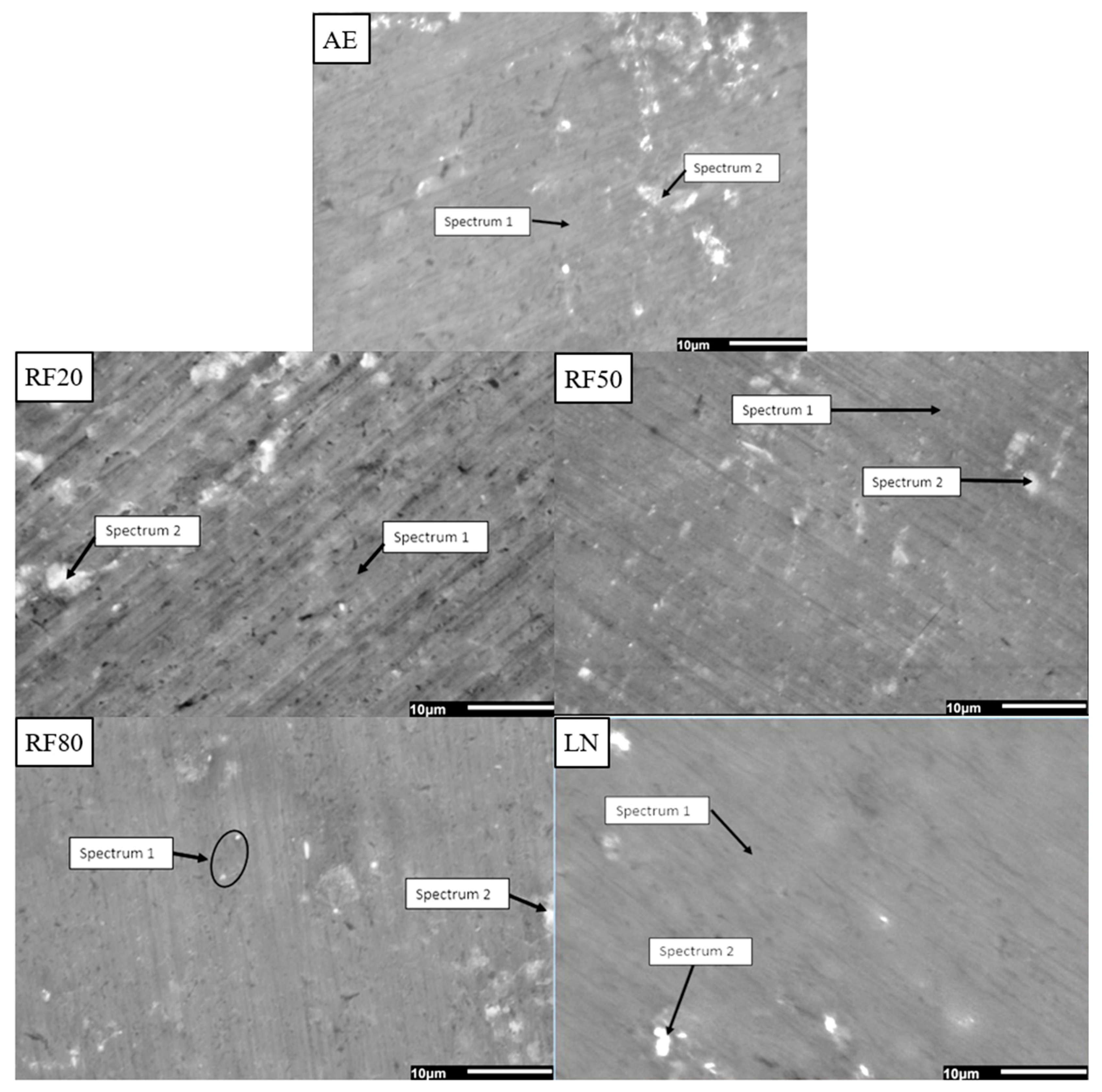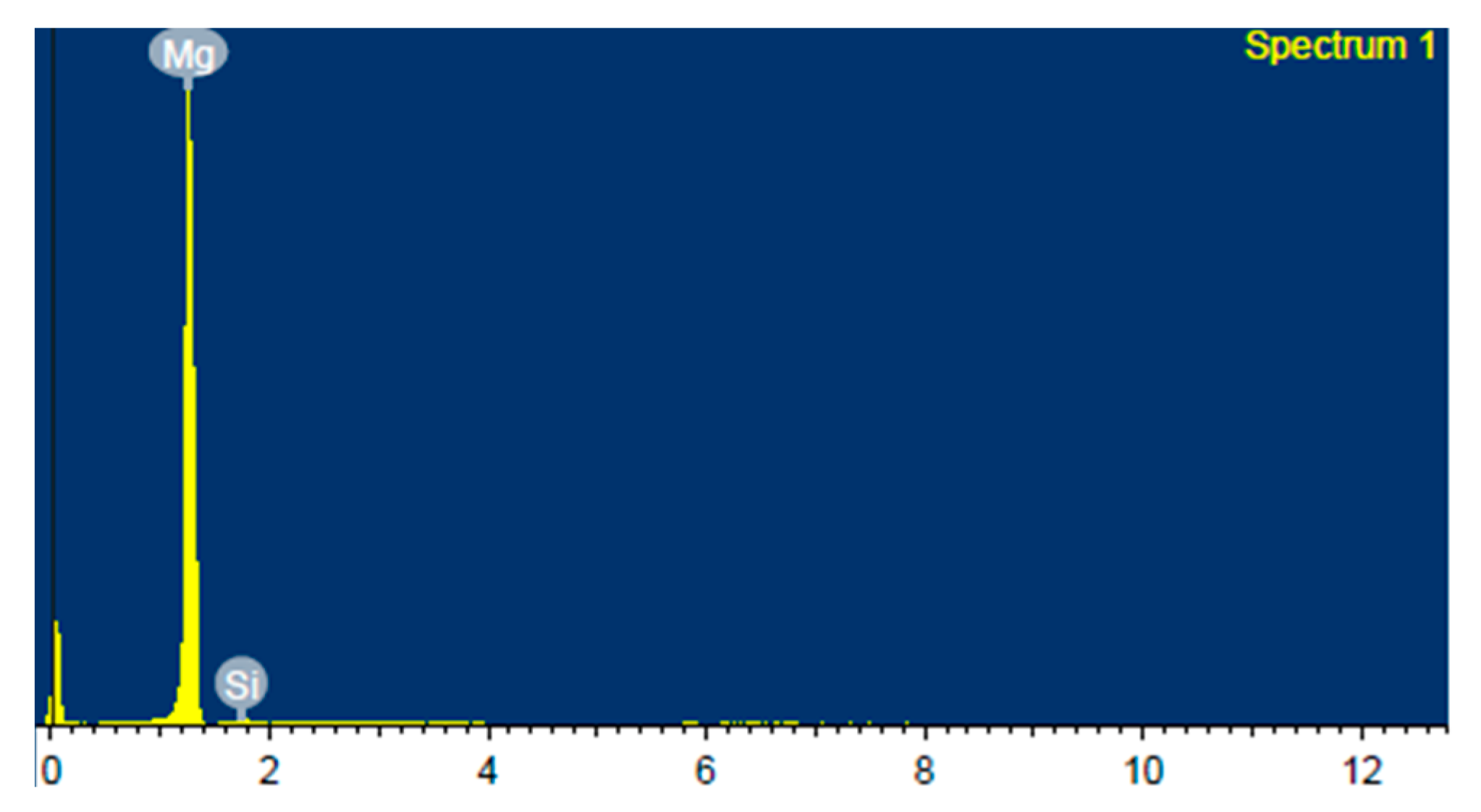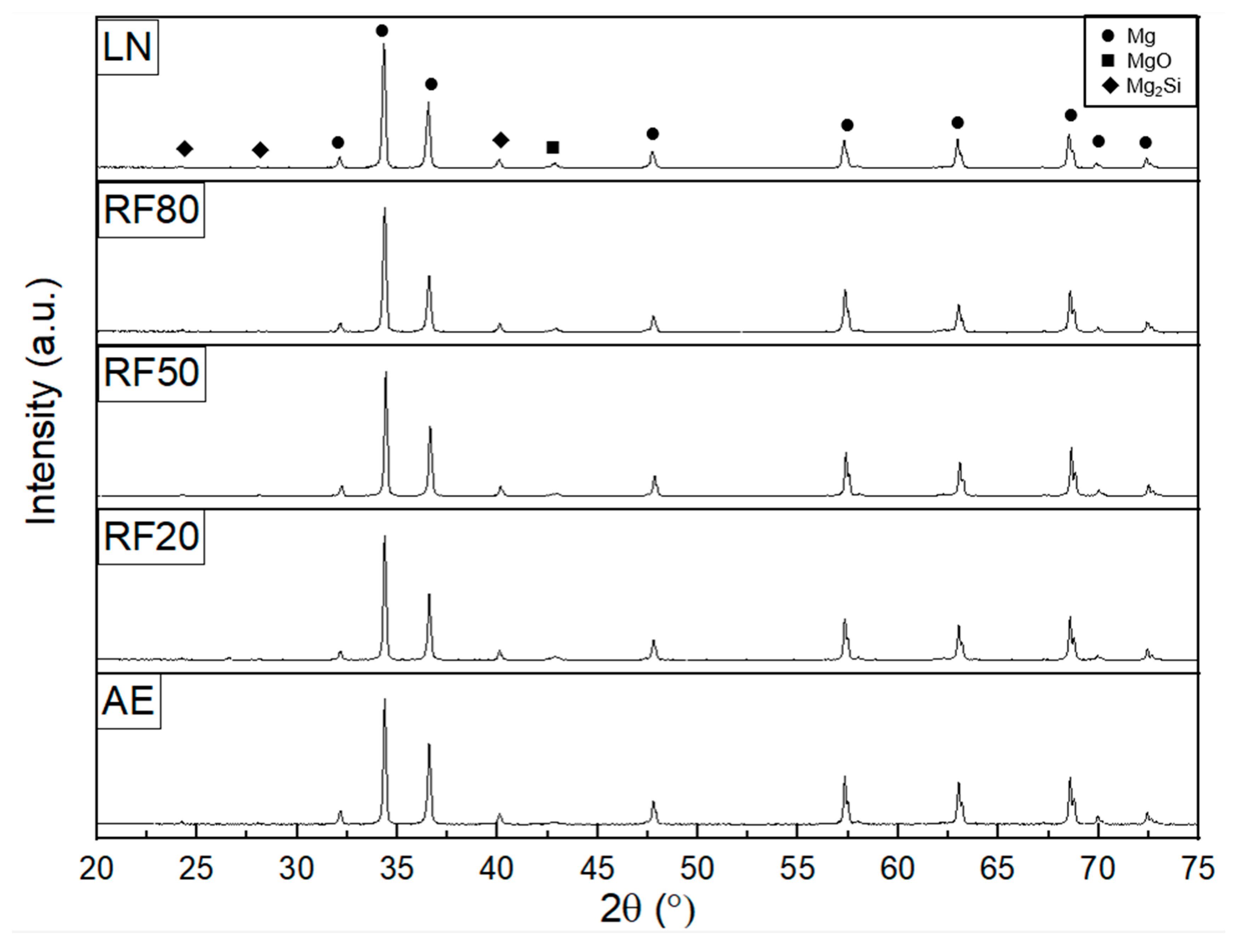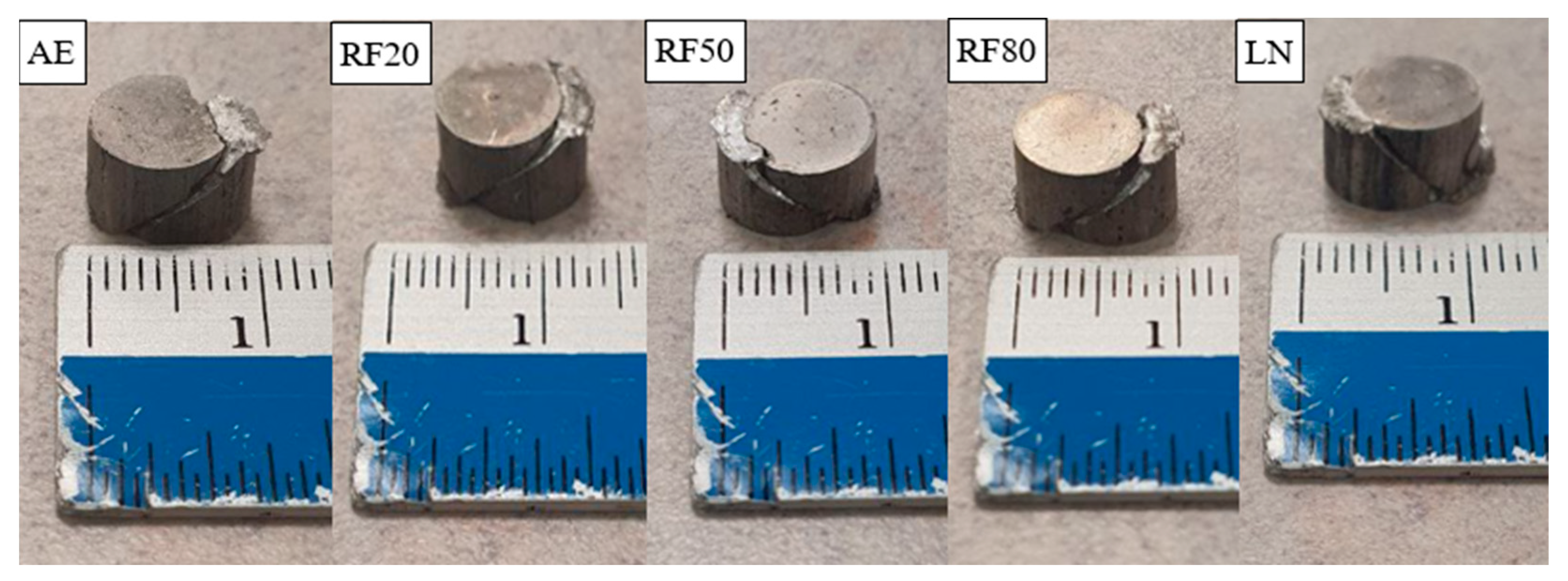An Insight into the Varying Effects of Different Cryogenic Temperatures on the Microstructure and the Thermal and Compressive Response of a Mg/SiO2 Nanocomposite
Abstract
:1. Introduction
2. Materials and Methods
2.1. Synthesis
2.2. Density and Porosity
2.3. Microstructural Characterization
2.4. Thermal Characterization
2.5. Mechanical Characterization
3. Results and Discussion
3.1. Density and Porosity
3.2. Microstructure
3.3. Thermal Response
3.4. Mechanical Response
4. Conclusions
- The greatest densification (33.6% reduction in porosity) was achieved with an exposure temperature of −80 °C.
- Cryogenic treatment reinforced existing textures by increasing the relative intensity of the already dominant basal texture.
- Exposure to −50 °C resulted in slight improvements in ignition resistance, with a 4 °C increase in ignition temperature.
- The damping properties of Mg-2SiO2 were most improved through exposure to −80 °C, with the attenuation coefficient improving by 7.5% and the damping capacity by 19.8%.
- The hardness of Mg-2SiO2 was most improved (31.8%) through exposure to −50 °C.
- The greatest improvements in compressive response were achieved through exposure to −20 °C, with improvements in yield strength (8.2% increase), fracture strain (2.9% increase), and energy absorbed (5.3% increase).
Author Contributions
Funding
Data Availability Statement
Acknowledgments
Conflicts of Interest
References
- Bhat Panemangalore, D.; Shabadi, R.; Tingaud, D.; Touzin, M.; Ji, G. Biocompatible silica-based magnesium composites. J. Alloys Compd. 2019, 772, 49–57. [Google Scholar] [CrossRef]
- Liu, C.; Ren, Z.; Xu, Y.; Pang, S.; Zhao, X.; Zhao, Y. Biodegradable Magnesium Alloys Developed as Bone Repair Materials: A Review. Scanning 2018, 2018, 9216314. [Google Scholar] [CrossRef] [PubMed]
- Mineral Commodity Summaries 2024. In Mineral Commodity Summaries; Report; USGS: Reston, VA, USA, 2024. Available online: https://pubs.usgs.gov/publication/mcs2024 (accessed on 12 April 2024).
- Ditze, A.; Scharf, C. Recycling of Magnesium Alloys. In Magnesium—Alloys and Technology; Wiley Online Books: Hoboken, NJ, USA, 2003; pp. 254–278. [Google Scholar] [CrossRef]
- Lapovok, R.Y.; Thomson, P.F. Production of dense rod from magnesium swarf for re-melting. Magnes. Technol. 2004, 1, 149–154. [Google Scholar]
- Li, L.; Zhang, M.; Li, Y.; Zhao, J.; Qin, L.; Lai, Y. Corrosion and biocompatibility improvement of magnesium-based alloys as bone implant materials: A review. Regen. Biomater. 2017, 4, 129–137. [Google Scholar] [CrossRef]
- Pacheco, K.A. Allergy to Surgical Implants. Clin. Rev. Allergy Immunol. 2019, 56, 72–85. [Google Scholar] [CrossRef] [PubMed]
- Jin, W.; Chu, P.K. Orthopedic Implants. In Encyclopedia of Biomedical Engineering; Narayan, R., Ed.; Elsevier: Oxford, UK, 2019; pp. 425–439. [Google Scholar] [CrossRef]
- Selvaraj, D.; Raja, J.; Prasath, S. Interdisciplinary approach for bilateral maxillary canine: First premolar transposition with complex problems in an adult patient. J. Pharm. Bioallied Sci. 2013, 5, S190–S194. [Google Scholar] [CrossRef] [PubMed]
- Ibrahim, H.; Moghaddam, N.S.; Elahinia, M. Mechanical and In Vitro Corrosion Properties of a Heat-Treated Mg-Zn-Ca-Mn Alloy as a Potential Bioresorbable Material. Adv. Metall. Mater. Eng. 2017, 1, 1–7. [Google Scholar] [CrossRef]
- Ravi Kumar, N.V.; Blandin, J.J.; Suéry, M.; Grosjean, E. Effect of alloying elements on the ignition resistance of magnesium alloys. Scr. Mater. 2003, 49, 225–230. [Google Scholar] [CrossRef]
- Tekumalla, S.; Joo Yuan, N.; Haghshenas, M.; Gupta, M. Enhancing Properties of Aerospace Alloy Elektron 21 Using Boron Carbide Nanoparticles as Reinforcement. Appl. Sci. 2019, 9, 5470. [Google Scholar] [CrossRef]
- Wan, Y.; Cui, T.; Li, W.; Li, C.; Xiao, J.; Zhu, Y.; Ji, D.; Xiong, G.; Luo, H. Mechanical and biological properties of bioglass/magnesium composites prepared via microwave sintering route. Mater. Des. 2016, 99, 521–527. [Google Scholar] [CrossRef]
- Michel, M.D.; Serbena, F.C.; Lepienski, C.M. Effect of temperature on hardness and indentation cracking of fused silica. J. Non-Cryst. Solids 2006, 352, 3550–3555. [Google Scholar] [CrossRef]
- Umeda, J.; Kawakami, M.; Kondoh, K.; Ayman, E.L.S.; Imai, H. Microstructural and mechanical properties of titanium particulate reinforced magnesium composite materials. Mater. Chem. Phys. 2010, 123, 649–657. [Google Scholar] [CrossRef]
- Goh, C.S.; Gupta, M.; Wei, J.; Lee, L.C. The Cyclic Deformation Behavior of Mg—Y2O3 Nanocomposites. J. Compos. Mater. 2008, 42, 2039–2050. [Google Scholar] [CrossRef]
- Jaganathan, H.; Godin, B. Biocompatibility assessment of Si-based nano- and micro-particles. Adv. Drug Deliv. Rev. 2012, 64, 1800–1819. [Google Scholar] [CrossRef] [PubMed]
- Maquet, V.; Boccaccini, A.R.; Pravata, L.; Notingher, I.; Jérôme, R. Porous poly(α-hydroxyacid)/Bioglass® composite scaffolds for bone tissue engineering. I: Preparation and in vitro characterisation. Biomaterials 2004, 25, 4185–4194. [Google Scholar] [CrossRef]
- Roether, J.A.; Boccaccini, A.R.; Hench, L.L.; Maquet, V.; Gautier, S.; Jérôme, R. Development and in vitro characterisation of novel bioresorbable and bioactive composite materials based on polylactide foams and Bioglass® for tissue engineering applications. Biomaterials 2002, 23, 3871–3878. [Google Scholar] [CrossRef] [PubMed]
- Vergnol, G.; Ginsac, N.; Rivory, P.; Meille, S.; Chenal, J.-M.; Balvay, S.; Chevalier, J.; Hartmann, D.J. In vitro and in vivo evaluation of a polylactic acid-bioactive glass composite for bone fixation devices. J. Biomed. Mater. Res. Part B Appl. Biomater. 2016, 104, 180–191. [Google Scholar] [CrossRef] [PubMed]
- Bruckmann, F.D.; Nunes, F.B.; Salles, T.D.; Franco, C.; Cadoná, F.C.; Bohn Rhoden, C.R. Biological Applications of Silica-Based Nanoparticles. Magnetochemistry 2022, 8, 131. [Google Scholar] [CrossRef]
- Johanes, M.; Gupta, M. An Investigation into the Potential of Turning Induced Deformation Technique for Developing Porous Magnesium and Mg-SiO2 Nanocomposite. Materials 2023, 16, 2463. [Google Scholar] [CrossRef]
- Sonar, T.; Lomte, S.; Gogte, C. Cryogenic Treatment of Metal—A Review. Mater. Today Proc. 2018, 5, 25219–25228. [Google Scholar] [CrossRef]
- Zurecki, Z. Cryogenic Quenching of Steel Revisited. In Heat Treating, Proceedings of the 23rd ASM Heat Treating Society Conference, Pittsburgh, PA, USA, 25–28 September 2005; ASM: Almere, The Netherlands, 2006. [Google Scholar]
- Baldiserra, P.; Delprete, C. Deep Cryogenic Treatment: A Bibliographic Review. Open Mech. Eng. J. 2008, 2008, 1–11. [Google Scholar] [CrossRef]
- Gupta, S.; Parande, G.; Gupta, M. Comparison of Shallow (−20 °C) and Deep Cryogenic Treatment (−196 °C) to Enhance the Properties of a Mg/2wt.%CeO2 Nanocomposite. Technologies 2024, 12, 14. [Google Scholar] [CrossRef]
- Gupta, S.; Parande, G.; Tun, K.S.; Gupta, M. Enhancing the Physical, Thermal, and Mechanical Responses of a Mg/2wt.%CeO2 Nanocomposite Using Deep Cryogenic Treatment. Metals 2023, 13, 660. [Google Scholar] [CrossRef]
- Dong, N.; Sun, L.; Ma, H.; Jin, P. Effects of cryogenic treatment on microstructures and mechanical properties of Mg-2Nd-4Zn alloy. Mater. Lett. 2021, 305, 130699. [Google Scholar] [CrossRef]
- ASTM E9-09; Standard Test Methods of Compression Testing of Metallic Materials at Room Temperature. ASTM International: West Conshohocken, PA, USA, 2018.
- Xie, S.; Lv, Q.; Zhang, W.; Qu, Y.; Qi, H.; Yu, B.; Li, R.; Li, G.; Yang, F. Effect of Cryogenic Treatment on Microstructure and Mechanical Properties of Al0.6CrFe2Ni2 Dual-Phase High-Entropy Alloy. Metals 2023, 13, 195. [Google Scholar] [CrossRef]
- Gates-Rector, S.; Blanton, T. The Powder Diffraction File: A quality materials characterization database. Powder Diffr. 2019, 34, 352–360 (PDF-4+ 2023). [Google Scholar] [CrossRef]
- Gupta, S.; Johanes, M.; Parande, G.; Gupta, M. An Investigation into the Effect of Length Scale of Reinforcement on the Cryogenic Response of a Mg/2wt.%CeO2 Composite. Micro 2024, 4, 170–184. [Google Scholar] [CrossRef]
- Colakoglu, M. Factors effecting internal damping in aluminum. J. Theor. Appl. Mech. 2004, 42, 95–105. [Google Scholar]
- Xie, Z.-k.; Tane, M.; Hyun, S.-k.; Okuda, Y.; Nakajima, H. Vibration–damping capacity of lotus-type porous magnesium. Mater. Sci. Eng. A 2006, 417, 129–133. [Google Scholar] [CrossRef]
- Kováčik, J. Correlation between Young’s modulus and porosity in porous materials. J. Mater. Sci. Lett. 1999, 18, 1007–1010. [Google Scholar] [CrossRef]
- Rivera-Salinas, J.E.; Gregorio-Jáuregui, K.M.; Romero-Serrano, J.A.; Cruz-Ramírez, A.; Hernández-Hernández, E.; Miranda-Pérez, A.; Gutierréz-Pérez, V.H. Simulation on the Effect of Porosity in the Elastic Modulus of SiC Particle Reinforced Al Matrix Composites. Metals 2020, 10, 391. [Google Scholar] [CrossRef]







| Material Designation | Treatment Performed |
|---|---|
| AE | As-extruded (no treatment) |
| RF20 | Refrigeration at −20 °C for 24 h |
| RF50 | Refrigeration at −50 °C for 24 h |
| RF80 | Refrigeration at −80 °C for 24 h |
| LN | Liquid nitrogen exposure at −196 °C for 24 h |
| Treatment | Average Experimental Density (g/cm3) | Porosity Reduction (%) | |
|---|---|---|---|
| Before Treatment | After Treatment | ||
| RF20 | 1.794 ± 0.006 | 1.794 ± 0.002 | 0 |
| RF50 | 1.793 ± 0.002 | 1.796 ± 0.003 (↑0.167%) | 7.0 |
| RF80 | 1.787 ± 0.001 | 1.800 ± 0.004 (↑0.727%) | 33.6 |
| LN | 1.789 ± 0.012 | 1.800 ± 0.006 (↑0.615%) | 26.3 |
| Treatment | Spectrum | Detected Element (wt.%) | ||
|---|---|---|---|---|
| Mg | Si | O | ||
| AE | 1 | 97.7 | 2.3 | - |
| 2 | 88.6 | 2.4 | 9.0 | |
| RF20 | 1 | 100 | - | - |
| 2 | 88.0 | 2.3 | 9.7 | |
| RF50 | 1 | 97.4 | 1.1 | 1.5 |
| 2 | 87.1 | 7.0 | 5.9 | |
| RF80 | 1 | 96.0 | 1.8 | 2.2 |
| 2 | 92.9 | 1.8 | 5.4 | |
| LN | 1 | 100 | - | - |
| 2 | 95.5 | 1.5 | 3.1 | |
| Treatment | Plane | I/Imax |
|---|---|---|
| AE | 10-10 prism | 0.1181 |
| 0002 basal | 1 | |
| 10-11 pyramidal | 0.6450 | |
| RF20 | 10-10 prism | 0.0854 |
| 0002 basal | 1 | |
| 10-11 pyramidal | 0.5373 | |
| RF50 | 10-10 prism | 0.0898 |
| 0002 basal | 1 | |
| 10-11 pyramidal | 0.5670 | |
| RF80 | 10-10 prism | 0.0825 |
| 0002 basal | 1 | |
| 10-11 pyramidal | 0.4610 | |
| LN | 10-10 prism | 0.0965 |
| 0002 basal | 1 | |
| 10-11 pyramidal | 0.5326 |
| Treatment | Average CTE (×10−6/K) | Ignition Temperature (°C) |
|---|---|---|
| AE | 22.95 | 602 |
| RF20 | 23.63 | 604 |
| RF50 | 23.07 | 606 |
| RF80 | 22.79 | 604 |
| LN | 24.00 | 603 |
| Treatment | Attenuation Coefficient | Damping Capacity | E-Modulus (GPa) |
|---|---|---|---|
| AE | 41.8 | 0.001238 | 47.54 ± 0.28 |
| RF20 (pre-treatment) | 48.42 | 0.001433 | 48.26 ± 0.28 |
| RF20 (post-treatment) | 49.31 (↑1.8%) | 0.001292 (↓9.6%) | 49.06 ± 0.29 (↑1.7%) |
| RF50 (pre-treatment) | 38.73 | 0.001288 | 48.15 ± 0.28 |
| RF50 (post-treatment) | 35.19 (↓9.1%) | 0.001174 (↓8.9%) | 48.23 ± 0.38 (↑0.2%) |
| RF80 (pre-treatment) | 38.09 | 0.001104 | 48.23 ± 0.28 |
| RF80 (post-treatment) | 40.94 (↑7.5%) | 0.001322 (↑19.8%) | 48.23 ± 0.38 (no change) |
| LN (pre-treatment) | 44.54 | 0.001344 | 48.71 ± 0.29 |
| LN (post-treatment) | 44.88 (↑0.8%) | 0.0001352 (↑0.6%) | 48.67 ± 0.29 (↓0.1%) |
| Treatment | Average Microhardness (HV) |
|---|---|
| AE | 85 ± 7 |
| RF20 | 86 ± 6 (↑1.2%) |
| RF50 | 112 ± 8 (↑31.8%) |
| RF80 | 104 ± 5 (↑22.4%) |
| LN | 86 ± 5 (↑1.2%) |
| Treatment | Average 0.2% Yield Strength (MPa) | Average Ultimate Compressive Strength (MPa) | Average Failure Strain (%) | Average Work of Fracture (MJ/m3) |
|---|---|---|---|---|
| AE | 158 ± 2 | 380 ± 11 | 27.6 ± 0.4 | 60.8 ± 1.8 |
| RF20 | 171 ± 1 (↑8.2%) | 381 ± 12 (↑0.3%) | 28.4 ± 1.2 (↑2.9%) | 64.0 ± 3.7 (↑5.3%) |
| RF50 | 152 ± 3 (↓3.8%) | 389 ± 11 (↑2.4%) | 27.6 ± 1.2 | 63.2 ± 3.1 (↑4.0%) |
| RF80 | 154 ± 7 (↓2.5%) | 385 ± 10 (↑1.3%) | 27.5 ± 1.3 (↓0.4%) | 60.9 ± 4.9 (↑0.2%) |
| LN | 164 ± 1 (↑3.8%) | 383 ± 1.4 (↑0.8%) | 28.4 ± 1.04 (↑2.9%) | 63.9 ± 4.3 (↑5.1%) |
Disclaimer/Publisher’s Note: The statements, opinions and data contained in all publications are solely those of the individual author(s) and contributor(s) and not of MDPI and/or the editor(s). MDPI and/or the editor(s) disclaim responsibility for any injury to people or property resulting from any ideas, methods, instructions or products referred to in the content. |
© 2024 by the authors. Licensee MDPI, Basel, Switzerland. This article is an open access article distributed under the terms and conditions of the Creative Commons Attribution (CC BY) license (https://creativecommons.org/licenses/by/4.0/).
Share and Cite
Johanes, M.; Mehtabuddin, S.; Venkatarangan, V.; Gupta, M. An Insight into the Varying Effects of Different Cryogenic Temperatures on the Microstructure and the Thermal and Compressive Response of a Mg/SiO2 Nanocomposite. Metals 2024, 14, 808. https://doi.org/10.3390/met14070808
Johanes M, Mehtabuddin S, Venkatarangan V, Gupta M. An Insight into the Varying Effects of Different Cryogenic Temperatures on the Microstructure and the Thermal and Compressive Response of a Mg/SiO2 Nanocomposite. Metals. 2024; 14(7):808. https://doi.org/10.3390/met14070808
Chicago/Turabian StyleJohanes, Michael, Sarah Mehtabuddin, Vishal Venkatarangan, and Manoj Gupta. 2024. "An Insight into the Varying Effects of Different Cryogenic Temperatures on the Microstructure and the Thermal and Compressive Response of a Mg/SiO2 Nanocomposite" Metals 14, no. 7: 808. https://doi.org/10.3390/met14070808







